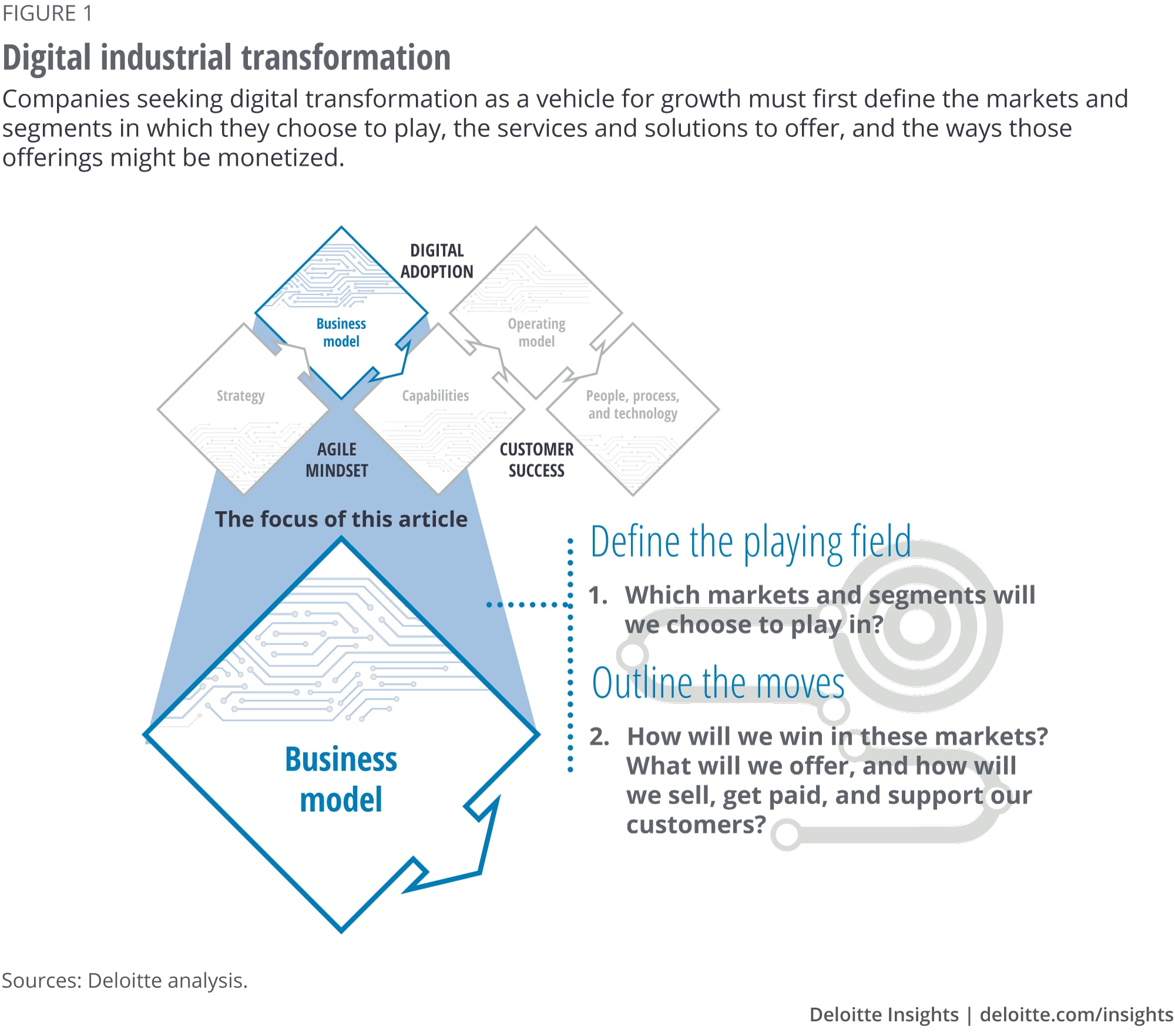
Digital transformation as a path to growth Capturing new market opportunity
8 minute read
15 July 2019
Many companies have yet to explore the full potential of Industry 4.0 and digital transformation as a growth driver. This article, third in a series, outlines an approach to help leaders bridge the business of today and tomorrow.
Disruptive technologies, introduced at an unprecedented rate, are driving the Industry 4.0 revolution,1 and companies that can successfully harness the potential of these technologies can enjoy exponential growth. Yet a recent Deloitte study suggests a disconnect between Industry 4.0’s market potential and its attainability, and most companies are using advanced technologies for near-term business operations rather than truly transformative opportunities.2 Thus, even executives who are ready to invest in digital industrial transformation may see it more as a defensive move rather than an offensive or growth-oriented play.3
Learn More
Explore the Digital industrial transformation collection
Explore the Industry 4.0 collection
Download the Deloitte Insights and Dow Jones app
Subscribe to receive related content
But a growing number of digital industrial companies are looking forward by viewing their internally focused, efficiency-driven transformations as a stepping stone to future growth.4 In fact, organizations can view their productivity-focused transformations as a set of training wheels when seeking new opportunity, finding and training new talent,5 and defining agile ways of working. We explain this concept in the previous article of our digital industrial transformation series, in which we discuss how to set a digital transformation north star.6
Daimler Trucks Asia is one example of a company undergoing its own internal transformation while entering new growth areas with new products and services. Its transformation started with the quality management department implementing proactive sensing solutions, powered by data, to reduce warranty and recall costs. And the journey is continuing, with the company using its internal transformation to jump-start its broader ambitions around connected fleet services.7
Hitachi Vantara is another example of a company undergoing a transformation while seeking growth opportunities in helping its customers transform. COO Scott Kelly explains: “I’ve read that around 85 percent of companies have yet to build an ‘official’ digital transformation strategy. What really resonates with our customers is the fact that we are recognized as doing what IDC describes as an ‘authentic’ digital transformation. This means we bring real-life experience of transformation as well as digital solutions to support our customers on their transformation journeys.”8
For companies ready to explore harnessing digital transformation for growth, this article outlines how to frame the opportunity by defining the playing field, or the markets and segments in which they choose to play, and outlining the winning moves, or the services and solutions to offer and how to monetize. (See figure 1 as reference for our overall digital transformation framework.)

After articulating the transformation north star, defining the business model is the next step for a company on the digital transformation journey. Decisions around target customers; use cases; and delivery, monetization and support models have broad implications for a company’s capabilities, operating model, and supporting systems. Without addressing these specifics, companies risk executing on a transformation fated to fall short of delivering on leaders’ growth ambitions.
Defining the playing field
Because new digital markets are in many instances still nascent, determining where to begin can be challenging. Potential applications for the Industrial IoT, for example, are virtually limitless. When faced with choice overload, companies can easily get stuck in endless “science experiments” or, worse, remain frozen in place.9
So how do leaders determine where to start, in terms of which segments of the new markets to claim as their own? They need to combine an outside-in lens with an inside-out one.
An outside-in lens focuses on isolating the industry verticals and use cases that have the greatest market potential, based on projected market size, market growth rate, and competitive intensity. When taking the outside-in lens, it is important to take a sufficiently broad view, both in time horizon and in the definition of relevant industry verticals and use cases. A focus on a longer time horizon may seem counterintuitive in a rapidly changing world, but it can help executives understand just how differently their companies will need to operate in the uncertain markets of the future, in addition to the tactical adjustments they need to make to accommodate today’s market shifts. Without a sufficiently wide aperture, companies may again find themselves trapped in incremental initiatives focused on short-term events, at the risk of being disrupted rather than being the disruptors. When taking the outside-in lens, executives should ground their thinking in how customers—and the ecosystem in which they interact with customers and partners—may evolve. Other tactics to support outside-in thinking include scenario planning and hiring external thought experts, futurists, and provocateurs.10
An inside-out lens helps companies understand their own ability to lead in any market segment. This can be approximated through assessments of the company’s current domain expertise, proximity to commercialization of innovation efforts, internal capabilities, brand credibility, and the strength of its ecosystem. When evaluating these points, leaders need to be realistic. For example, many incubation efforts require significant refinement and hardening to make them market-ready. Moreover, customer interest in an incubation experiment alone is insufficient evidence that it can be scaled to become a commercially viable business. Luckily, many of these dimensions can be easily tested—for example, brand credibility can be gauged through interviews and focus groups with a subset of the company’s most strategic customers and partners.
Layering both lenses on top of each other yields an intersection of verticals and use cases that form a playing field for the company’s areas for growth. What happens when the areas of biggest opportunity do not seem to intersect with a company’s current domain expertise? While this could suggest a misalignment between ambition and reality, the right application of this outside-in plus inside-out approach enables leaders to find the right balance; they can think of their immediate focus areas—leveraging their current strengths—as stepping stones that bridge to opportunities further afield. The key is to identify adjacencies between the existing business and the desired opportunities, such as horizontal technologies or capabilities. Figure 2 offers a conceptual representation of this approach.

Hewlett Packard Enterprise’s IoT business serves as an excellent example of this stepping-stone approach toward future growth areas. Understanding that IoT technology represented a large market opportunity, the company narrowed in on a set of prioritized industry verticals (for example, manufacturing, retail, public sector, life sciences and health care, and telecom) and use cases (for example, predictive maintenance, asset management and tracking, intelligent spaces buildings and venues, future cities, and connected vehicles). HPE chose this set of focus areas based on its expertise in core data centers, edge computing, wireless solutions, and IoT project delivery.11 To supplement its own growing portfolio of IoT capabilities, the company also built a robust partner ecosystem with hardware equipment manufacturers, other software players, and global systems integrators.12 By starting industries and use cases closer to its core business and rounding out its own capabilities with those partners, HPE made a credible first step in its IoT growth journey.
Outlining the moves
Once you’ve defined the playing field, it’s time to answer a set of deeper questions about your business model. These can be thought of as your winning moves. The business model has increasingly become the basis of competitive differentiation in creating, delivering, and capturing value in the digital realm. In fact, in Deloitte’s most recent Industry 4.0 report, 48 percent of executives indicated that introducing new business models was one of the top five topics discussed most frequently within their organization, yet only half of those leaders consider themselves ready for new business models.13
Defining your winning moves in the digital solutions space involves answering the following questions:
What will you sell? What portions of the digital solution stack will you offer? Will you target OEMs or owner/operators?
How will you sell? On which ecosystem partners will you rely to sell through and sell with? Are there new ecosystems you need to forge, and new partners to recruit?
How will you get paid? Will you charge a subscription, or charge based on consumption or outcome?
Figure 3 summarizes the winning moves—called such because they define how you can capture market opportunity. And because your strategy is as much about what you do as what you don’t do, each choice has associated trade-offs and associated implications that are important to understand.

One leading cloud computing and platform virtualization company seeking to enter the IoT market knew that it had to define all business model components, not just “what to sell.” Leaders had also hoped that defining all business model components upfront would drive the focus across the organization required to move quickly. To define the company’s IoT strategy, leaders conducted extensive benchmarking of competitors against a comprehensive set of dimensions. They researched not only competitor offerings but bundling and packaging, pricing models and pricing tiers, routes to market, and monetization models. This extensive competitor scan across all these dimensions revealed the market’s true white space, allowing the company to define a truly unique offering and build a more robust business case.14
Your winning moves will have profound implications for your operations and your organization. For example, shifting from a subscription- to a consumption-based monetization model affects everything from new sales enablement training to new finance and accounting processes to new back-end systems. In our previous article in this series, we discussed how to set the transformation north star, specifically outlining the transformation’s long-term vision and short- and medium-term objectives, and what the transformation means for your customers.15 After defining your winning moves, it is important to conduct a “feedback loop” check to your transformation north star, to ensure that the two are consistent. At Hitachi Vantara, the shift from a term license model to a subscription model resulted in a decrease in revenue in the initial year; the management team’s ability to strategically communicate this impact to internal and external stakeholders in a way consistent with its transformation north star has proved critical to the company’s longer-term success.
As with a company’s playing field, its winning moves can evolve over time. Just as you are undergoing a transformation, your customers likely are in the middle of their own. They may prefer an on-premise solution today but acknowledge the need to shift to a hybrid environment tomorrow. It is to your advantage to articulate an evolution that synchronizes with the one your customers envision.
Making the move
Tackling new markets and new business models is risky, but if done the right way, it can yield significant returns. In fact, executives who undertake digital transformation for innovation are nearly as likely to report significant ROI as those driven by operational goals.16 By proactively focusing digital transformation efforts on growth, companies can anticipate the shifts in the market before competitors and build sustainable competitive advantage.
To start, define your playing field, or your markets and customer segments of focus. Balance ambition and realism by layering a market- and customer-driven, outside-in lens, with an inside-out lens that pragmatically assesses your organization’s capabilities. If no overlaps currently exist, identify stepping stones, or adjacencies to your current business, that can help bridge your organization from its current strengths to the desired future opportunity areas.
Next, outline your moves by defining your business model. It is not enough to simply define what you will sell (your target customers and what you will offer to them)—consider how you will sell (your routes to market) as well as how you will get paid (your monetization model). Keep in mind that new business models—catering to new and unmet customer needs, monetizing data, etc.—can yield just as much opportunity, and be as much of a disruptor, as defining new products and services.
Once you have defined the playing field and your winning moves, it’s time to act. This last step is often the most important—it signals your commitment to the market, your employees, and your competitors. But this is where executives often hesitate, trapped in analysis paralysis. What they overlook during this period of indecision, however, is the cost of doing nothing. In Industry 4.0’s rapidly changing landscape, those who hesitate risk being left behind. As Hitachi Vantara’s Scott Kelly remarked, “The digital transformation and IoT markets are growing exponentially. There’s almost no bad place to start. The most important thing is to make a move, and test and learn. The worst thing to do is wait.”
© 2021. See Terms of Use for more information.
Explore more on Industry 4.0
-
Digital industrial transformation Article5 years ago
-
Staying focused and on track in Industry 4.0 Article5 years ago
-
Ethical technology use in the Fourth Industrial Revolution Article5 years ago
-
Forces of change: Industry 4.0 Article7 years ago
-
Industry 4.0: At the intersection of readiness and responsibility Article5 years ago
-
The Industry 4.0 paradox Collection6 years ago













